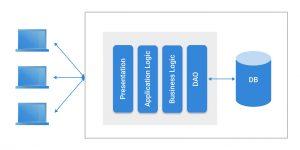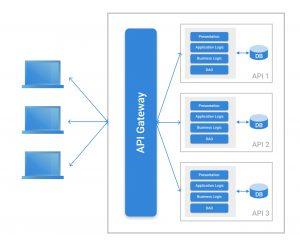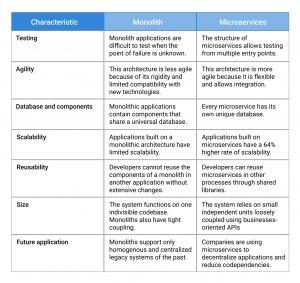
The debate about monolithic and microservices architectures has gained steam recently, with companies like Amazon and Google switching to microservices. While one side of the discussion prefers the stability of monolithic applications, the other side prefers the flexibility that microservices offer.
And this prompts the question: should developers use a monolithic architecture or split their application into microservices?
In this article, we’ll explore the definition and working principles of monolithic and microservices applications. Continue reading to find out the pros and cons of using both software development models.
When you build an application on a single-tiered layer of interdependent components, this architecture is called a monolithic architecture.

As the name suggests, a “monolithic” architecture consists of indivisible units coupled together to handle different operations in the application.
At its core, a monolithic architecture comprises the user interface, a server-side application, and a database (locally-hosted or cloud-based).
Monolithic architectures lack modularity, since you cannot decouple the components into independent parts.
Most developers and engineers prefer monolithic architecture because it is the traditional way of building software programs — you work with a single codebase for the entire application.
Since you are working with a single codebase, the debugging process becomes more linear and straightforward. Testers can also run end-to-end testing services across the application’s entire architecture.
Monolithic applications are easy to utilize because you only need to deploy one file or directory. Also, the lack of modularity allows you to focus on a single, centralized ecosystem.
When working on a small project, say a minimum viable product or proof of concept, you can use a monolithic architecture for the application. By doing so, you’ll save costs and deliver the MVP in time.
If you want to build an application that doesn’t require scaling, monolithic software architecture can solve your problems.
Although issues like network latency may occur, they are less frequent than with microservices.
Monolithic architectures degrade gradually over time due to the constant addition of new components. Eventually, the application deteriorates to such a state that it takes longer to process requests.
As the codebase grows, the architecture becomes more complex to understand. For example, new developers hopping onto a new project will struggle to comprehend the changes to the entire codebase — even with air-tight documentation.
Monolithic applications present scalability issues because of their rigidity, which is a massive issue for companies seeking to grow and expand their services.
Although most monolithic applications start as simple units, the architecture grows with time and becomes more complex. As a result, any repair effort will require a massive investment of time and resources.
Monolithic applications are challenging to upgrade. First, you need to find the module to update; then, you must implement inventive ways to integrate new services without breaking the entire application. And after making changes — no matter how minuscule — you must redeploy the whole application.
Since monolithic software often has only one point of failure, any error or malware attack can crash the entire system. Even with rigorous testing, experienced QA specialists might struggle to find the source of this software failure.
If your application comprises multiple independent units, this is the microservices architecture model. Microservices carry out specific functions controlled by unique databases for each component.
When an application is split into microservices, the separate units carry out unique functions. Each unit contains servers and databases that are independent of each other — and can hence be reused in other processes.

Most importantly, the microservice architecture relies on business-oriented APIs that combine everything into a cohesive application. This gives them a higher level of modularity than monolithic architecture.
All the components of a microservice architecture are independent, allowing you to redeploy them in other applications without affecting other units.
Since every microservice unit is a separate entity, developers and engineers can easily spot flaws in the application and fix them promptly. They can also conduct full-scale testing across multiple units — or pinpoint the problem area.
With every microservice functioning on its own, you can choose the components to scale or leave as is. This attribute gives your application more flexibility and makes it scalable.
Microservices are easy to manage if you have a basic understanding of the architecture. This clarity helps developers and testers spot issues faster and decipher ways to implement solutions.
Any application that uses microservices is agile. Making changes to one microservice allows you to redeploy it without disrupting other components. Also, you can add and test new technologies easily.
As the system expands, the microservices architecture takes on more components, making it more difficult to manage. You also have to deploy every service (microservice) independently.
When an application malfunctions, diagnosing the problem and debugging the code could be a massive challenge under certain conditions. For example, if the system is distributed across multiple, complex microservices, testers may not spot an easy fix, and often need to debug every unit separately to pinpoint the origin of the issue.
Since every microservice requires individual servers and databases to run specific operations, the cost increases as you add more units. Additionally, you may need to hire engineers for specific microservices, which adds to the overall maintenance cost.
The presence of multiple units in the distributed systems introduces various points of failure and vulnerabilities in the microservice architecture. Even if one microservice is affected, the others will continue functioning.
These days, most tech companies model their software development processes on either the lean, waterfall or agile methodology. Some also have a unique DevOps approach dedicated to only software development.
But since 71% of companies use the agile model, let’s explore how it pertains to the monoliths and microservices.

According to O’Reilly, 61% of companies have implemented microservices over the past five years, with a 55% “complete success” rate. Also, data from DZone shows that 73% of companies believe that microservices will become indispensable for building next-gen software applications.
And with companies like Uber, Netflix, Amazon, and Spotify switching to microservices, it is no secret that the pendulum is swinging in the direction of microservices architecture.
Besides, microservices allow you to build applications with failure in mind. By factoring in possible downtimes and maintenance, you get better control over unprecedented shortcomings in the future.
But that doesn’t spell absolute doom for monoliths. Developers can still use a monolithic architecture to build lightweight applications that require no updates — a calculator application, for example.
Also, companies with small teams — working on a simple project or creating a proof of concept — can build monolithic applications. This architecture offers better performance, since shared-memory access is faster than inter-process communication.
And above all, engineers and developers are already exploring the idea of combining monoliths and microservices into the modular monolith — a hybrid module where the code powers a single application and enforces strict boundaries between different domains.
Shopify’s use of modular monoliths shows promise in the following areas:
Choosing between monoliths and microservices should follow a systematic approach to solving a specific software development problem, rather than simply following trends. Although tech giants are adopting microservices, your company or startup might not benefit from adopting this architecture.
Consult with your engineers and developers to determine the best course of action for your development processes. And most importantly, start working on a modular monolith architecture to get the best of both worlds.